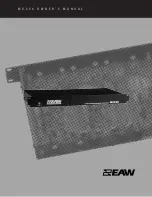
1
The MX250 Close-Coupled Electronic Processor™ (CCEP) is a two-channel,two-way electronic crossover designed for
use in both fixed installations and touring sound systems.It is factory-configured for use with specific EAW loudspeaker
systems.This ensures optimum system performance and relieves the end user from the burden of configuration.
This design continues EAW’s commitment to the primary importance of total system design in controlling a
loudspeaker’s ability to maximize its outputs within your application.
Features Overview
The MX250 CCEP™ incorporates a unique combination of features and design innovations that set it apart from conventional crossover
networks and permit its precise adjustment for a particular EAW speaker system. EAW Engineering completed all the guesswork that you would
normally perform with a conventional crossover in an attempt to attain the optimum parameters for each speaker system.
N O N - C O I N C I D E N T F I L T E R S
When necessary, the MX250 CCEP incorporates a non-coincident filter system.This means that the high-frequency and low-frequency filters
aren’t restricted to the same corner frequency—contributing to the system’s overall superior acoustic performance.The filter types for both
high frequencies and low frequencies are 24 dB-per-octave Linkwitz-Riley. Careful analysis of the MX250’s electrical performance and the loud-
speaker’s acoustical performance remain key elements in the close coupling of the crossover to a particular speaker system.The end result of
the close coupling process corrects acoustic response at the crossover frequency rather than depending on an “idealized”electrical response.
Optimum crossover frequencies and filter shapes for each speaker system configuration have been determined, and incorporated at the
factory as the MX250 CCEP’s presets.The label on the rear of the unit confirms the configuration.
Technical Description
O P E R A T I O N A L S U M M A R Y
The MX250 CCEP functions as a stereo two-way crossover or as a stereo two-way crossover with additional summed monaural low and high
outputs. EAW presets the MX250 as part of the configuration process. Unlike most outboard crossover devices, we optimize this device for a
particular combination of EAW subwoofers and full-range speakers or for bi-amping specific EAW full-range systems.The configuration of
your unit is labeled on the back of the MX250 CCEP chassis.
The crossover filters use 4th order Linkwitz-Riley alignments, which yield a 24 dB per octave slope. By measuring the actual acoustical output
of the various combinations of EAW speakers, EAW’s Engineering department has calculated the optimal crossover frequencies for each
configuration.Your MX250 CCEP has been preset at the factory using separate high-pass and low-pass filter modules.The summed output
configuration is also preset at the factory.
If you wish to reconfigure your MX250 CCEP for a different speaker system contact the EAW Service Department at 800-992-5013
(508-234-6158), fax 508-234-3376.The MX250 CCEP is not intended to be modified in the field.
E N C L O S U R E
The steel chassis of the MX250 CCEP is designed and built to withstand the abuse and jostling of portable and mobile applications while
ensuring reliable operation.The chassis is one rack-space tall (1.75 in.; 44.5 mm) and has a depth of 8.16 in. (207.3 mm).
The inputs and outputs are 3-pin XLR connectors on the rear panel of the chassis; two females for the inputs, and six males for the outputs.
A C P O W E R
The MX250 CCEP has a universal power supply compatible with virtually any AC power source throughout the world today. An internal switch
sets the power supply for either 95-130 VAC (50-60 Hz) or 190-260 VAC (50-60 Hz) operation. A label on the rear of the MX250 indicates the
factory voltage setting.
The AC power line cord attaches to the MX250 CCEP chassis via an IEC-230 connector on the rear panel. Check and insure the AC line cord
mains cable and voltage setting are correct for the power source. An incorrect voltage switch setting could cause severe damage to the unit.




























